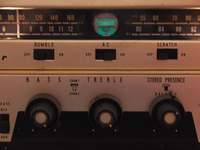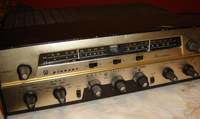     |
Pioneer
claimed in his advertising leaflets that it was possible to
extract the power of 2 x 12 W from the SM-B200A. I guess there was
something to it, because with effective speakers you could listen
to music loud and clear, and the sound coming out of this baby was
a real pleasure. The receiver could also be liked, for lovers of
"monuments" its line is a typical example of industrial "design"
from the 1950s. On the shelf it presented itself as something from
a completely different era. Transverse division of the front into
two marked levels, very symmetrical arrangement of knobs and other
elements in golden and black colors. And characteristic, like the
windows in cars of that time, the narrow scale. But also,
especially during work, the "magic eye" added beauty. The lamp -
6G-E12 is unique even in comparison to the equipment from those
years, it has two "displays". This in turn is related to the
design of this receiver. The SM-B200A has two monaural tuners. One
picks up medium and short waves and the other picks up medium and
FM waves. To listen in stereo, you had to find a station
transmitting on two frequencies (e.g. medium wave) or even wave
(FM and medium). Each tuner received one channel (left or right).
Therefore, the magic eye has two sections. Of course, earlier you
had to set the appropriate channel, range, etc. on the switches /
selectors. In addition, the SM-B200A also has the option of using
an external decoder working in the MPX system. One of the switches
has the appropriate position - FM MPX, on the back there is an
output to an external stereo decoder and two inputs. It was enough
to buy an external MPX decoder type MXA-1A or MXA-3A and enjoy
stereo on the FM range. But it was only after a few years, because
at the moment of starting the production of the SM-B200, the FM
stereo was in the experimental phase. This baby is built on 15
tubes, and although it comes from the 1950s, it also has 4
low-noise germanium transistors 2SB73 used in a phono-microphone
preamplifier. This is an exception when it comes to Pioneer,
because in later designs there were no longer any transistors.
Without this system, it would be a treat for lovers of the
so-called "Full tube", because the power supply is rectified on
the 5AR4 / GZ34 tube. It provides energy for two pairs of 6BM8 /
ECL82 tubes working in the Push & Pull system. The triode
parts of these tubes are used as driving lamps for the pentode
parts (power) and as one stage of the preamplifier. In front of
them there is one stage on the 12AX7 (ECC83) tube. Between them
there is the bass / treble control and the "STEREO PRESENCE"
control. This potentiometer adjusts the width of the stereo
effect. There are volume and balance controls in front of the
12AX7, switches "LOUDNESS" - dynamics, "SCRATCH" and
"RUMBLE". Of course, this is what high-cut and low-cut
filters used to be called. Tuners (as mentioned before) the
receiver has two. No. 1 is controlled by the "SELECTOR 1" switch.
Its ranges are medium and short waves 4-12 MHz received by two
tubes 6BA6 / EF93 and 6BE6 / EK90. Radios signal was rectified
on a germanium diode. The second tuner - "SELECTOR 2" is
much more complex. Its tubes are in the AM part (only medium
waves) a repetition of the tuner 1. However, the FM range is more
extensive. Head on two 6AQ8 /ECC85 and three IF stages on
6BA6 / EF93 ended with germanium diodes demodulation. Sensitivity
on the FM range is good, a dozen or so stations from a piece of
wire. The AM bands required a wire antenna as they did not have a
ferrite antenna in the design. The amplifier built on the 6BM8 is
surprising. It is hard to believe that from two such tubes you can
get such a volume with very low distortions. Pioneer was building
similar equipment throughout the 1960s. The SX-34 and SX-34B
models are the successors of the SM-B200A. Although they also have
a great performance and MPX decoder, the older relative is more
"powerful". At least it has such a structure. |